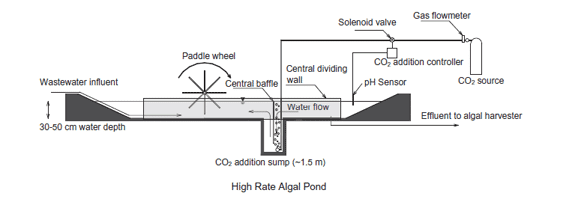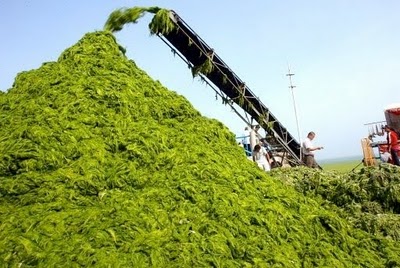
Algae wastewater treatment facilities act as important bioremediation agents.
Algae wastewater treatment bioremediation can be defined as a process which
- Uses metabolism abilities of microorganisms to remove pollutants and contaminants. Algae have tremendous potential to be used for waste water remediation and using algae in a wider scope compared to current commercial use is being emphasized.

Algae wastewater treatment of municipal, industrial, and agricultural wastes employing stabilization ponds or lagoons has found increasing application within the past 20 or 30 years.
Where land values are not excessive, the low cost of construction and operation and the demand for less technical competence in their operation compared with more sophisticated treatment facilities make lagooning, in one form or the other, the method of choice for the stabilization of many different types of waste materials.
Combining algae waste water treatment with biofuel production is an economically feasible process. The waste water treatment plants are an invaluable source of algal biomass which serve as a bright prospect for many industries and companies that use algae as a feedstock for a variety of purposes.
Industries using algae wastewater treatment for commercial purposes include meat and poultry industry, paper and textile industry, industries using dyes and pigments, breweries, pharmaceuticals, bio-fertilizer production units and metal finishing industries. Other industries include:

- Poultry
- Dairy
- Aquaculture
- Textiles
- Pulp and Paper
- Distillery & Breweries
- Leather
- Foods
- Petrochemicals
- Pharmaceuticals
- Chemicals
- Mining
- Metalworking
The composition of effluent from industries is a lot different from the composition of domestic wastes. Treatment of industrial effluent is targeted at the removal of excess concentrations of nitrogen, phosphorus and other organic matter.
Algae are used for waste water treatment as they remove undesirable substances by biodegradation. Organic matter in water is broken down to smaller components such as CO2, ammonia and phosphates.

A niche opportunity may, however, exist where algal biomass is grown as a by-product of wastewater treatment in high rate algal ponds (HRAPs). HRAPs are shallow, open raceway ponds and have been used for treatment of municipal, industrial and agricultural wastewaters. Large-scale production of algal biofuels using wastewater treatment HRAPs was first proposed by Oswald and Golueke (1960). The algal biomass produced and harvested from these wastewater treatment systems could be, and have been, converted through various pathways to biofuels.
You also be interested in...

Algae Animal Feed
Most algae have a natural high protein content while a high oil content is mostly achieved though manipulation of cultivation conditions. Read More

Algae Bioplastics
“The day where we hit 95 dollars a barrel I think all of a sudden you’re going to see algae bio-plastics basically explode,” That day has come...Read More

Algae in Aquaculture
From fish farms to fish food, algae aquaculture is booming. With the rising price of fish food many aquaculturists are growing their own...Read More
The Algae Revolution Has Begun
You have demonstrated this is not complex. We can do this.
Dear David,
I am a small farmer that is suffering from the Economic downturn and would not have had the finances to afford it at this time. I believe your work in research on algae and your willingness to share with us maybe at the center of new world wide wealth for the under privileged. The greatest aspect of your work is the empowering of the little people. You’re making us aware we have other choices, we will no longer in bondage the big energy companies. You have demonstrated this is not complex. We can do this.
Oregon, USA



